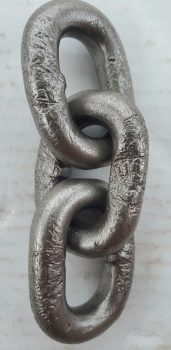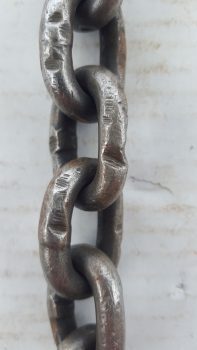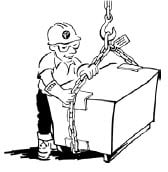Contributed by Bob Kozickie, Technical Sales Support Manager
Alloy chain slings are required to be inspected by a competent person once in every 12 month period as defined in OSHA 1910.184, and as mentioned in a previous post. Some of the criteria for alloy chain slings to be removed from service are clearly defined; others rely on the judgement and experience of the chain sling inspector to make the final determination as to the extent of damage. Wear, for example, has a definitive amount of material that has been eroded away from the link before it must be removed from service and tagged for repair. (The Table of Wear can be found on Page 11 of the Peerless Chain Sling User’s Manual.) Other criteria such as nicks and gouges are judgement decisions based on experience and knowledge. This justifies the fact that a chain sling inspector is required to be a “Competent Person”.
 Nicks occur as a result of the alloy chain coming in contact with a sharp corner on the load. This usually happens when the load is being lifted and the full tension of the loads’ weight is embedding into the steel. As this continues to repetitively happen, the nicks become more numerous and visually obvious. As the number of these serrations that the chain exhibits increases, the more they will weaken the link. The frequency of this occurring will continue to deteriorate the links until such a time when the chain could potentially fail when under load.
Nicks occur as a result of the alloy chain coming in contact with a sharp corner on the load. This usually happens when the load is being lifted and the full tension of the loads’ weight is embedding into the steel. As this continues to repetitively happen, the nicks become more numerous and visually obvious. As the number of these serrations that the chain exhibits increases, the more they will weaken the link. The frequency of this occurring will continue to deteriorate the links until such a time when the chain could potentially fail when under load.
 Gouges are a result of alloy chain sling moving while under load. A gouge will start off as a simple nick but once the chain sling starts to adjust to the load, the sharp edge will then scrape into the surface of the alloy steel links. This occurrence is most likely to happen when the load is rigged in a basket or choke configuration. Depending on the diameter of the chain and the amount of weight that the chain is lifting, will be the determining factor as to the depth of the gouge. Gouges will also weaken the chain considerably. The concern becomes increasingly greater when the gouge occurs closer to the crown or bent end of the link since this is the weakest area. There are ways to prevent or lessen nicks and gouges, especially deep ones from occurring. The chain sling user is required by OSHA to pad or protect the chain from exposure to sharp corners or edges.
Gouges are a result of alloy chain sling moving while under load. A gouge will start off as a simple nick but once the chain sling starts to adjust to the load, the sharp edge will then scrape into the surface of the alloy steel links. This occurrence is most likely to happen when the load is rigged in a basket or choke configuration. Depending on the diameter of the chain and the amount of weight that the chain is lifting, will be the determining factor as to the depth of the gouge. Gouges will also weaken the chain considerably. The concern becomes increasingly greater when the gouge occurs closer to the crown or bent end of the link since this is the weakest area. There are ways to prevent or lessen nicks and gouges, especially deep ones from occurring. The chain sling user is required by OSHA to pad or protect the chain from exposure to sharp corners or edges.
 A wear pad placed on the alloy chain at or near the point of contact with the load is critical in protecting the chain from severe and potentially dangerous damage. A wear pad can be something as simple as a piece of rubber tire or a piece of old nylon sling that has been cut into sections and placed between the load and the lifting sling. More sophisticated wear pads are available. Some examples can be a detachable or sliding nylon wear pad placed onto the sling, Pukka Pad, or even fire hose with Velcro to attach it to the sling. If a solid wear pad is placed onto the sling during assembly, it cannot cover more than 49% of the slings chain length. The Sling Manufacturer must remember that alloy chain slings are required to have a link by link inspection each day before being used. A wear pad placed onto the entire chain leg length is unable to be inspected and therefore must be removed from service.
A wear pad placed on the alloy chain at or near the point of contact with the load is critical in protecting the chain from severe and potentially dangerous damage. A wear pad can be something as simple as a piece of rubber tire or a piece of old nylon sling that has been cut into sections and placed between the load and the lifting sling. More sophisticated wear pads are available. Some examples can be a detachable or sliding nylon wear pad placed onto the sling, Pukka Pad, or even fire hose with Velcro to attach it to the sling. If a solid wear pad is placed onto the sling during assembly, it cannot cover more than 49% of the slings chain length. The Sling Manufacturer must remember that alloy chain slings are required to have a link by link inspection each day before being used. A wear pad placed onto the entire chain leg length is unable to be inspected and therefore must be removed from service.
Prevention and preparation are two steps that can be taken to extend the service life of alloy chain slings. The occurrence of nicks and gouges are an example of lack of training and respect for the rigging hardware components. A good, well trained, and competent inspector can make the determination as to whether or not to allow the sling to remain in service. Rigging training classes presented to the riggers using alloy chain slings are the best source provider to insure that everyone is aware of the proper use, care, maintenance and inspection of their slings. Alloy chain sling training classes are available through your local Peerless Chain distributor.